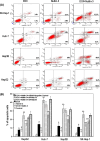Nutlin-3 cooperates with doxorubicin to induce apoptosis of human hepatocellular carcinoma cells through p53 or p73 signaling pathways
- PMID: 20174822
- PMCID: PMC11827909
- DOI: 10.1007/s00432-010-0817-8
Nutlin-3 cooperates with doxorubicin to induce apoptosis of human hepatocellular carcinoma cells through p53 or p73 signaling pathways
Erratum in
-
Correction to: Nutlin-3 cooperates with doxorubicin to induce apoptosis of human hepatocellular carcinoma cells through p53 or p73 signaling pathways.J Cancer Res Clin Oncol. 2021 Nov;147(11):3457-3458. doi: 10.1007/s00432-021-03543-4. J Cancer Res Clin Oncol. 2021. PMID: 33528639 Free PMC article. No abstract available.
Abstract
Purpose: Despite recent advances in chemotherapeutic agents for Hepatocellular carcinoma (HCC) treatment, the results of chemotherapy remain unsatisfactory. Doxorubicin (DOX) still represents the cornerstone in HCC chemotherapy, but resistance and toxicity to normal cells are major obstacles to successful chemotherapy. Therefore, new active agents in HCC chemotherapy and agents that increase the chemosensitivity of HCC cells to DOX are still urgently required. Nutlin-3 is a small-molecule inhibitor that acts to inhibit murine double minute-2 (MDM2) binding to p53 or p73, and subsequently activates p53- or p73-dependent apoptosis signaling pathway. This study was designed to investigate whether Nutlin-3 alters cell toxicity to HCC cells following DNA damage and to assess the suitability of DOX/Nutlin-3 as a chemotherapeutic combination in HCC chemotherapy.
Methods: Four human HCC cells were analyzed using cell proliferation assay, apoptosis assay, western blotting, co-immunoprecipitation and siRNA experiments. Anti-tumoral effects of Nutlin-3/DOX targeting the p53/MDM2 and p73/MDM2 pathways were evaluated in HCC cell lines.
Results: Nutlin-3 enhances the growth inhibition by DOX and potentates the apoptotic effect in all HCC cell lines with different p53 types. Nutlin-3 acts through the disruption of p53-MDM2 binding in HepG2, and the disruption of p73-MDM2 in Huh-7 and Hep3B cell lines with subsequent activation of the apoptotic pathway, which leads to the increase in chemosensitivity to DOX in HCC cells.
Conclusions: Taken together, our findings suggest that Nutlin-3 will be active in the treatment of HCC and offers new prospects for overcoming DOX resistance.
Figures




Similar articles
-
Disruption of p73-MDM2 binding synergizes with gemcitabine to induce apoptosis in HuCCT1 cholangiocarcinoma cell line with p53 mutation.Tumour Biol. 2010 Aug;31(4):287-95. doi: 10.1007/s13277-010-0035-7. Epub 2010 Apr 27. Tumour Biol. 2010. PMID: 20422343
-
MDM2 antagonist can inhibit tumor growth in hepatocellular carcinoma with different types of p53 in vitro.J Gastroenterol Hepatol. 2011 Feb;26(2):371-7. doi: 10.1111/j.1440-1746.2010.06440.x. J Gastroenterol Hepatol. 2011. PMID: 21261729
-
EVA1A reverses lenvatinib resistance in hepatocellular carcinoma through regulating PI3K/AKT/p53 signaling axis.Apoptosis. 2024 Aug;29(7-8):1161-1184. doi: 10.1007/s10495-024-01967-0. Epub 2024 May 14. Apoptosis. 2024. PMID: 38743191
-
Percutaneous ethanol injection or percutaneous acetic acid injection for early hepatocellular carcinoma.Cochrane Database Syst Rev. 2015 Jan 26;1(1):CD006745. doi: 10.1002/14651858.CD006745.pub3. Cochrane Database Syst Rev. 2015. PMID: 25620061 Free PMC article.
-
Sequencing of systemic therapy in unresectable hepatocellular carcinoma: A systematic review and Bayesian network meta-analysis of randomized clinical trials.Crit Rev Oncol Hematol. 2024 Dec;204:104522. doi: 10.1016/j.critrevonc.2024.104522. Epub 2024 Sep 26. Crit Rev Oncol Hematol. 2024. PMID: 39332750
Cited by
-
MDM2-p53 Interactions in Human Hepatocellular Carcinoma: What Is the Role of Nutlins and New Therapeutic Options?J Clin Med. 2018 Mar 27;7(4):64. doi: 10.3390/jcm7040064. J Clin Med. 2018. PMID: 29584707 Free PMC article. Review.
-
A balancing act: orchestrating amino-truncated and full-length p73 variants as decisive factors in cancer progression.Oncogene. 2015 Aug 13;34(33):4287-99. doi: 10.1038/onc.2014.365. Epub 2014 Nov 10. Oncogene. 2015. PMID: 25381823 Review.
-
Investigating Core Signaling Pathways of Hepatitis B Virus Pathogenesis for Biomarkers Identification and Drug Discovery via Systems Biology and Deep Learning Method.Biomedicines. 2020 Aug 31;8(9):320. doi: 10.3390/biomedicines8090320. Biomedicines. 2020. PMID: 32878239 Free PMC article.
-
MDM2 antagonist Nutlin-3a potentiates antitumour activity of cytotoxic drugs in sarcoma cell lines.BMC Cancer. 2011 May 30;11:211:1-11. doi: 10.1186/1471-2407-11-211. BMC Cancer. 2011. PMID: 21624110 Free PMC article.
-
Doxorubicin induces apoptosis by targeting Madcam1 and AKT and inhibiting protein translation initiation in hepatocellular carcinoma cells.Oncotarget. 2015 Sep 15;6(27):24075-91. doi: 10.18632/oncotarget.4373. Oncotarget. 2015. PMID: 26124182 Free PMC article.
References
-
- Artandi SE, Attardi LD (2005) Pathways connecting telomeres and p53 in senescence, apoptosis, and cancer. Biochem Biophys Res Commun 331(3):881–890 - PubMed
-
- Bálint E, Bates S, Vousden KH (1999) Mdm2 binds p73 alpha without targeting degradation. Oncogene 18(27):3923–3929 - PubMed
-
- Carr BI (2004) Hepatocellular carcinoma: current management and future trends. Gastroenterology 127:S218–S224 - PubMed
-
- Chen X, Zhang M, Liu LX (2009) The overexpression of multidrug resistance-associated proteins and gankyrin contribute to arsenic trioxide resistance in liver and gastric cancer cells. Oncol Rep 22(1):73–80 - PubMed
MeSH terms
Substances
LinkOut - more resources
Full Text Sources
Other Literature Sources
Medical
Research Materials
Miscellaneous

